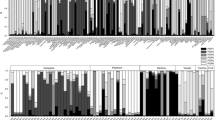Abstract
Single-strand conformaiton polymorphism (SSCP) profiles of six PCR-amplified fragments (250–800 bp) were analyzed in three full-sib families of pedunculate oak (Quercus robur L.) and their parents. Among the six fragments, four were polymorphic and one exhibited complex patterns that were not changed by varying the SSCP conditions. The number of bands for the analyzed fragments varied between two and four among individuals regardless of fragment size. As shown by segregation data, the variation in the number of bands between trees could only be attributed to the allelic composition (homozygotes vs heterozygotes): a genotype that exhibited two bands was presumptively homozygous, wheras a genotype exhibiting three or four bands was heterozygous. Mendelian proportions were observed in all crosses for each polymorphic fragment. In one cross, we could clearly identify a null allele due to a possible mutation at a primer site. Single-base mutations and short insertion-deletions were shown to be the molecular causes of the SSCP polymorphism observed between different alleles. The use of SSCP as a technique to identify co-dominant markers of PCR fragments (up to 800 bp) is recommended for gene diversity studies or for gene mapping.
Similar content being viewed by others
References
Bassam BJ, Caeteno-Anolles G, Gresshoff PM (1991) Fast and sensitive silver staining of DNA in polyacrylamide gels. Anal Biochem 196:80–83
Boge A, Gerstmeier R, Einspanier R (1994) Molecular polymorphism as a tool for differentiating ground beetles (Carabus species): application of ubiquitin PCR/SSCP analysis. Insect Mol Biol 3:267–271
Cai Q, Touitou I (1993) Excess PCR primers may dramatically affect SSCP efficiency. Nucleic Acids Res 21:3909–3910
Condie A, Eeles R, Borresen AL, Coles C, Cooper C, Prosser J (1993) Detection of point mutation in the p53 gene: comparison of single-strand conformation polymorphism, constant denaturant gel electrophoresis, and hydroxylamine and osmium tetroxide techniques. Hum Mutat 2:58–66
Dockhorn-Dworniczak B, Dworniczak B, Brömmelkamp L, Bülles J, Horst J, Böcker WW (1991) Non-isotopic detection of singlestrand conformation polymorphism (PCR-SSCP): a rapid and sensitive technique in diagnosis of phenylketonuria. Nucleic Acids Res 19:2500
Doyle JJ, Doyle JL (1990) Isolation of plant DNA from fresh tissue. Focus 12:13–15
Fukuoka S, Inoue T, Miyao A, Monna L, Zhong HS, Sasaki T, Minobe Y (1994) Mapping of sequence-tagged sites in rice by single-strand conformation polymorphism. DNA Res 1:271–277.
Glavac D, Dean M (1993) Optimization of the single-strand conformation polymorphism (SSCP) technique for detection of point mutations. Hum Mutat 2:404–414
Hayashi K, Yandell DW (1993) How sensitive is PCR-SSCP? Hum Mutat 2:338–346
Hongyo T, Buzard GS, Calvert RJ, Weghorst CM (1993) ‘Cold SSCP’: a simple, rapid and non-radioactive method for optimized single-strand conformation polymorphism analyses. Nucleic Acids Res 21:3637–3642
Kasuga T, Cheng J, Mitchelson KR (1995) Metastable single-strand DNA conformational polymorphism analysis results in enhanced polymorphism detection. PCR Methods Applic 4:227–233
Kirkpatrick BW, Hart GL (1994) Conformation polymorphisms and targeted marker development. Anim Genet 25:77–82
Lenk U, Hanke R, Speer A (1994) Carrier detection in the DMD family with point mutations, using PCR-SSCP and direct sequencing. Neuromusc Disord 5/6:411–418
Leren TP, Solberg K, Rodningen OK, Ose L, Tonstad S, Berg K (1993) Evaluation of running conditions for SSCP analysis: application of SSCP for detection of point mutation in the LDL receptor gene. PCR Methods Applic 3:159–162
Maekawa M, Sudo K, Kanno T (1993) Search for improved electrophoretic conditions for PCR-single-strand conformation polymorphism analysis: is an SDS buffer condition useful? PCR Methods Applic 3:130–132
Michaud J, Brody LC, Steel G, Fontaine G, Martin LS, Valle D, Mitchell G (1992) Strand-separating conformational polymorphism analysis: efficacy of detection of point mutations in the human ornithine d-aminotransferase gene. Genomics 13:389–394
Moreau F, Kleinschmit J, Kremer A (1994) Molecular differentiation between Q. Petraea and Q. Robur assessed by random amplified DNA fragments. For Genet 1:51–64
Orita M, Iwahana H, Kanazawa H, Hayashi K, Sekiya T (1989a) Detection of polymorphisms of human DNA by gel electropheresis as single-strand conformation polymorphisms. Proc Natl Acad Sci USA 86:2766–2770
Orita M, Suzuki Y, Sekiya T, Hayashi K (1989b) Rapid and sensitive detection of point mutations and DNA polymorphisms using the polymerase chain reaction. Genomics 5:874–879
Paran I, Michelmore RW (1993) Development of reliable PCR-based markers linked to downy mildew resistance genes in lettuce. Theor Appl Genet 85:985–993
Sarkar G, Yoon HS, Sommer SS (1992) Screening for mutations by RNA single-strand conformation polymorphism (rSSCP): comparison with DNA-SSCP. Nucleic Acids Res 20:871–878
Sheffield VC, Beck JS, Kwitek AE, Sandstrom DW, Stone EM (1993) The sensitiviy of single-strand conformation polymorphism analysis for the detection of single base substitutions. Genomics 16:325–332
Simon L, Levesque RC, Lalonde M (1993) Identification of endomycorrhizal fungi colonizing roots by fluorescent single-strand conformation polymorphism-polymerase chain reaction. Appl Envir Microbiol 59:4211–4215
Spinardi L, Mazars R, Theillet C (1991) Protocols for an improved detection of point mutations by SSCP. Nucleic Acids Res 19:4009
To KY, Liu CI, Chang YS (1993) Detection of point mutations in the chloroplast genome by single-stranded conformation polymorphism analysis. The Plant Jour 3:183–186
Tsai MY, Holzknecht RA, Tuchman M (1993) Single-strand conformational polymorphism and direct sequencing applied to carrier testing in families with ornithine transcarbamylase deficiency. Hum Genet 91:321–325
Widjojoatmodjo MN, Fluit ADC, Verhoef J (1994) Rapid identification of bacteria by PCR-single-strand conformation polymorphism. J Clin Microbiol 32:3002–3007
Zanetto A, Kremer A, Müller-Strack G, Hattemer HH (1996) Inheritance of isozymes in Pedunculate oak (Quercus robur L.) J Hered (in press)
Author information
Authors and Affiliations
Additional information
Communicated by J. Beckmann
Rights and permissions
About this article
Cite this article
Bodenes, C., Kremer, A. & Laigret, F. Inheritance and molecular variations of PCR-SSCP fragments in pedunculate oak (Quercus robur L.). Theoret. Appl. Genetics 93, 348–354 (1996). https://doi.org/10.1007/BF00223175
Received:
Accepted:
Issue Date:
DOI: https://doi.org/10.1007/BF00223175




